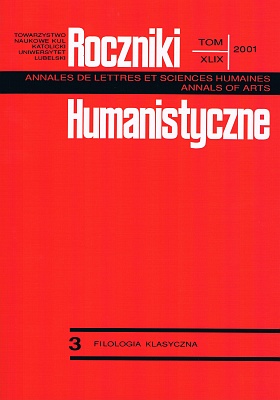The Auditorium and the Audience of the Greek Ancient Theatre
Abstract
The author deals with the auditorium of the Greek theatre in a twofold meaning: as a part of the stage building and as its audience who took seats in the theatre during performances. The first part of the paper depicts the following issues from the historical point of view: the auditorium of the Greek theatre as instanced by the most characteristic remnants of the ancient theatrical buildings, that is the size of the audience, its division into blocks of seats, benches for the audience, seats and seats of honour.
The second part deals with the theatrical audience: their number, their social composition, their behaviour during performances, relations between the stage and the audience. The latter aspect is more particularly exposed in the paper; the close relations between the spectators and actors have been discussed on the example of the texts of dramas (tragedy and ancient comedy) that have been preserved until now. As far as other particular issues are concerned, one should stress that the author is in favour of women in the theatre both during agons (dramatic contests) of tragedies, and in comedies, disputing in this matter with the opposite view presented by S. Goldhill (of 1997).
References
Arnott P.: Greek Scenic Conventions in the Fifth Century B.C. Oxford 1962.
Arnott P. D.: Public and Performance in the Greek Theatre. London 1989.
Bieber M.: The History of the Greek and Roman Theatre. Princeton 1961.
Blume H. D.: Einführung in das antike Theaterwesen. Darmstadt 19842.
Bernhardt M. L.: Sztuka grecka IV wieku p.n.e. Warszawa 1974.
Cartlege P.: „Deep Plays” − Theatre as Process in Greek Civic Life. W: The Cambridge Companion to Greek Tragedy. Ed. by P. E. Easterling. Cambridge 1997 s. 3-35.
Chodkowski R. R.: Życie Ajschylosa. Wstęp – Przekład − Komentarz. „Roczniki Humanistyczne” 41:1993 z. 3 s. 57-67.
Chodkowski R. R.: Funkcja obrazów scenicznych w tragediach Ajschylosa. Wrocław 1975.
Csapo E., Slater W. J.: The Context of Ancient Drama. Ann Arbor 1995.
Deforge B.: Eschyle poète cosmique. Paris 1986.
Dworacki S.: The Ending Formula in New Comedy. „Symbolae Philologorum Posnaniensium” 3:1977 s. 35-40.
Flacelière R.: Histoire littéraire de la Grèce. Paris 1962.
Gergan A. von; Mueller-Wiener W.: Das Theater von Epidauros. Stuttgart 1961.
Goldhill S.: The Audience of Athenian Tragedy. W: The Cambridge Companion to Greek Tragedy. Ed. by P. E. Easterlong. Cambridge 1997 s. 54-67.
Hammond N. G. L.: The Conditions of Dramatic Production to the Death of Aeschylus. „Greek, Roman and Byzantine Studies” 13:1972 nr 45 s. 387-450.
Henderson J. J.: Women and the Athenian Dramatic Festivals. „Transactions and Proceedings of the American Philological Association” 121:1991 s. 133-147.
Jaeger W.: Paideia. Przeł. M. Plezia. T. 1. Warszawa 1962.
Kaeppel L.: Das Theater von Epidauros. „Jahrbuch des Deutschen Archäologischen Institut” 1989 s. 83-106.
Lesky A.: Die tragische Dichtung der Hellenen. Göttingen 1972(3).
Łanowski J.: Pięć Eurypidejskich „końcówek”. „Eos” 84:1996 s. 237-241.
Melchinger S.: Das Theater der Tragödie. München 1974.
Miller S. G.: Ikria and orchestra − in Which Agora? W: Sources for the Ancient Greek City-State. Ed. by M. H. Hansen. Copenhagen 1995.
Pickard-Cambridge A.: The Dramatic Festivals of Athens. 2nd rev. by J. Gould and D. M. Lewis. Oxford 1968.
Pickard-Cambridge A.: The Theatre of Dionysus in Athens. Oxford 1966.
Podlecki A. J.: Could Women Attend the Theatre in Ancient Athens? ACollection of Testimonia. „Ancient World” 21:1990 s. 27-43.
Romilly J. de: La crainte et l'angoisse dans le théâtre d'Eschyle. Paris 1958.
Scullion S.: Tree Studies in Athenian Dramaturgy. Stuttgart 1994.
Srebrny S.: Teatr grecki i polski. Wybór i opracowanie Sz. Gąssowski. Wstęp J. Łanowski. Warszawa 1984.
Stanford W. B.: Greek Tragedy and the Emotions. London 1983.
Taplin O. P.: The Stagecraft of Aeschylus. Oxford 1977.
Wiles D.: Greek Theatre Performance. An Introduction. Cambridge 2000.
Wiles D.: Tragedy in Athens: Performance Space and Theatralical Meaning. Cambridge 1999.
Copyright (c) 2001 Roczniki Humanistyczne

This work is licensed under a Creative Commons Attribution-NonCommercial-NoDerivatives 4.0 International License.





